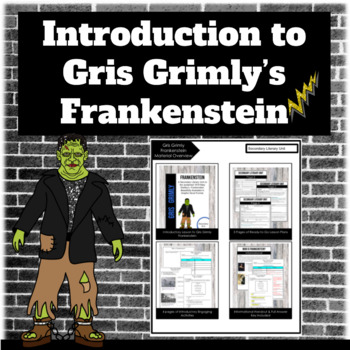Intro to Gris Grimly Frankenstein
- PDF
- Webquests
- Easel Activity
What educators are saying
Also included in
- Gris Grimly "Frankenstein".Complete Gris Grimly's graphic novel of Frankenstein Volume I and II.**Updated to include Volume II.**Gris Grimly's, Frankenstein, graphic novel is a part of our Science Fiction series designed to engage students in a fully illustrated version of Mary Shelley's 1818 origiPrice $14.99Original Price $21.99Save $7.00
Description
Gris Grimly "Frankenstein" by Mary Shelley.
Complete digital or print introduction to Gris Grimly's graphic novel of Frankenstein.
Gris Grimly's, Frankenstein, graphic novel is a part of our Science Fiction series designed to engage students in a fully illustrated version of Mary Shelley's 1818 original text.
**Please Note: This resources utilizes a website in order for students to complete a Webquest on Mary Shelley. Please check the website to ensure that you and your students have access before purchasing.**. https://kids.kiddle.co/Mary_Shelley
Included in this introduction is:
1. Complete Lesson Plans. Included is a complete three-page lesson plan making this perfect for observations, substitute plans, or an easy introductory lesson to Frankenstein.
2. Two pages of "Who is Frankenstein?" Students describe who/what they believe Frankenstein is and what it/he looks like. Then students either illustrate or insert a picture that portrays their answer to the previous question. Students then receive a handout explaining who Frankenstein is as well as who Mary Shelley is.
3. Mary Shelley Webquest. Who is Mary Shelley? Students will go to a kid friendly website and answer questions on the Life of Mary Shelley. This is a two page document. Page 1 has ten questions regarding Mary Shelley. Page 2 has two pictures in which students analyze using the See, Think, Wonder strategy.
4. Epigraph Analysis. An epigraph is a short quotation at the beginning of novels that usually gives clues to the main ideas of the novel. Here students will analyze and paraphrase the epigraph at the beginning of Gris Grimly's Frankenstein.
**Please note, the novel is NOT include and that this resource goes with the Gris Grimly's adaptation of Frankenstein by Mary Shelley. Over, the novel is not necessarily needed to complete this introductory activity.**
Would you like to receive notifications for my newly released packets and upcoming sale? Be sure to FOLLOW MEhere on TPT!
Let's Connect:
Follow me on Instagram
TeachingLit2021 Blog (coming soon)







